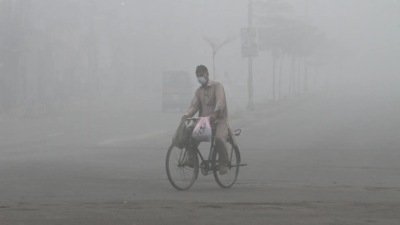
[ad_1]

Pakistan’s Air Quality Index (AQI) soared to unprecedented levels, sparking alarm across Punjab province as smog engulfed Lahore and Multan. According to Swiss air quality monitor IQAir, Lahore’s AQI rose to 760, while Multan reached a staggering 1,914, making it one of the most polluted cities worldwide.
The extreme pollution has left authorities scrambling to control the smog, with limited success reported.
Lahore, under a thick blanket of smog for days, has witnessed widespread road closures due to low visibility, leading to multiple accidents. A serious incident on GT Road near Kalashah Kako saw nine people injured when a van collided with a stationary truck, its driver unable to see the parked vehicle through the dense haze.
The smog has also forced Lahore high court to mandate a shutdown of all trade activities by 8 pm and close markets on Sundays, aiming to minimize pollution-inducing activity.
In Multan, conditions reached what experts called “apocalyptic” levels, with the AQI exceeding 2,000 on Friday morning. The concentration of PM2.5—a hazardous particulate matter known to cause severe respiratory and cardiovascular issues—was recorded at 947 micrograms per cubic meter, nearly 190 times above World Health Organization (WHO) guidelines. The WHO deems PM2.5 levels above five micrograms per cubic meter harmful.
In response, the state government is on high alert, implementing emergency measures to curb pollution levels. Public parks and museums across major cities have been closed until at least November 17.
Authorities have also faced criticism for failing to enforce preemptive anti-smog directives, with citizens often seen without masks despite the severe air quality.
Multan, the largest city in southern Punjab, recorded an extremely dangerous Air Quality Index (AQI) of 2,135 between 8am and 9am on Friday, according to data from IQAir, as reported by Dawn. Later in the day, the AQI readings remained perilous, reaching 980 by 10 pm—more than three times above the “hazardous” threshold of 300. Several monitors across Multan, including those at the WWF-Pakistan Office, Shamsabad Colony, and Multan Cantonment, showed AQI levels as high as 2,316, 1,635, and 1,527 respectively.
Authorities in Pakistan have attributed the worsening air quality in Lahore to cross-border winds carrying pollutants from neighboring India, alleging that these winds have pushed smog levels to “dangerous” extremes.
[ad_2]
Source link